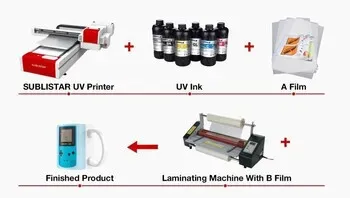In the realm of custom apparel production, **UV DTF technology** has emerged as a groundbreaking innovation that is reshaping printing methodologies. This advanced technique melds traditional Direct-to-Film (DTF) processes with the remarkable benefits of ultraviolet light curing, resulting in eye-catching and high-quality prints across a spectrum of materials. As businesses strive to meet modern customer demands, harnessing the advantages of UV DTF technology becomes essential for staying competitive in the market. Not only does this technique ensure vibrant colors and intricate designs, but it also emphasizes a sustainable printing approach, appealing to eco-conscious consumers. With its capability to produce superior print quality, UV DTF technology undoubtedly sets a new standard in the custom printing landscape.
UV DTF technology is part of a broader category of innovative printing solutions that are revolutionizing the apparel industry. Often referred to as ultraviolet Direct-to-Film printing, this cutting-edge method utilizes UV light for instantaneous curing, providing durability and vibrancy that traditional methods struggle to achieve. As businesses increasingly seek versatile and eco-friendly printing options, understanding these advanced techniques helps cater to diverse customer needs. Moreover, the quest for high-quality prints on custom apparel necessitates awareness of the latest developments in sustainable printing practices. By embracing these innovations, companies not only enhance their product offerings but also contribute positively to environmental efforts, thereby attracting a growing demographic of eco-conscious consumers.
The Rise of UV DTF Technology in Custom Apparel
In recent years, UV DTF technology has emerged as a game-changer in the custom apparel industry, making it easier for manufacturers to produce high-quality prints on various materials. This innovative approach combines the benefits of traditional Direct-to-Film printing with the rapid curing capabilities of ultraviolet light, allowing for stunning visual results. As competition intensifies, brands that adopt UV DTF technology can meet market demands with ease, offering customers vibrant and personalized apparel options.
With increased market adoption, many businesses are recognizing the advantages of UV DTF technology, from its exquisite print quality to its ability to cater to diverse substrate preferences. As companies seek to optimize their production processes and enhance product offerings, embracing UV DTF not only helps satisfy customer needs but also positions them as leaders in the custom apparel space. This technology is setting a new standard for print excellence and flexibility.
Frequently Asked Questions
What is UV DTF technology and how does it benefit custom apparel production?
UV DTF technology, or Direct-to-Film printing using ultraviolet light, enhances custom apparel production by providing high-quality, vibrant prints capable of adhering to various materials. The UV curing process ensures prints are durable and resistant to wear, making it ideal for businesses focused on creating long-lasting garments.
How does UV DTF technology compare to traditional DTF printing for custom apparel?
Unlike traditional DTF printing that relies on heat to cure inks, UV DTF technology utilizes ultraviolet light for instant curing. This innovation results in quicker production times, superior print quality, and greater versatility across multiple substrates, giving businesses an edge in the custom apparel market.
What are the environmental benefits of using UV DTF technology in sustainable printing?
UV DTF technology supports sustainable printing by using inks that emit fewer volatile organic compounds (VOCs) during application. This eco-friendly approach aligns with the growing demand for environmentally responsible practices in the custom apparel industry, making it a favorable option for brands looking to reduce their environmental impact.
Can UV DTF technology be used on a variety of materials for custom apparel?
Yes, UV DTF technology is highly versatile and can print on a wide range of materials including cotton, polyester, and even leather. This capability allows custom apparel businesses to meet diverse customer requests and offer unique clothing options.
What makes UV DTF prints more durable compared to other printing methods?
The durability of UV DTF prints comes from the UV curing process, which instantly solidifies the inks, making them highly resistant to washing, scratching, and fading. This resilience ensures that custom apparel remains vibrant and intact after numerous washes, offering customers superior longevity.
What are the turnaround times for custom apparel production using UV DTF technology?
With the quick curing capabilities of UV DTF technology, turnaround times for custom apparel production are significantly reduced. Businesses can fulfill orders rapidly without sacrificing print quality, enhancing customer satisfaction and loyalty through efficient service.
| Advantage | Description |
|---|---|
| High Print Quality | Prints with rich colors and sharp designs due to instant curing. |
| Versatility in Material Usage | Can print on various substrates including cotton, polyester, and leather. |
| Environmental Impact | Produces fewer VOCs, aligning with eco-friendly practices. |
| Durability of Prints | Highly resistant to washing, scratching, and fading. |
| Quick Turnaround Times | Significantly reduces production times, meeting customer demands. |
Summary
UV DTF technology is revolutionizing custom apparel production by offering unmatched advantages. This innovative printing method provides high-quality, durable prints while being versatile enough to work with a variety of materials. Companies adopting UV DTF technology can significantly reduce their environmental impact due to lower VOC emissions, making it an attractive choice for eco-conscious brands. Additionally, with quick turnaround times, businesses can efficiently meet growing consumer demands. As the apparel industry embraces UV DTF, it is likely to remain a key player in maximizing both quality and operational efficiency, setting a new standard for custom garment manufacturing.



